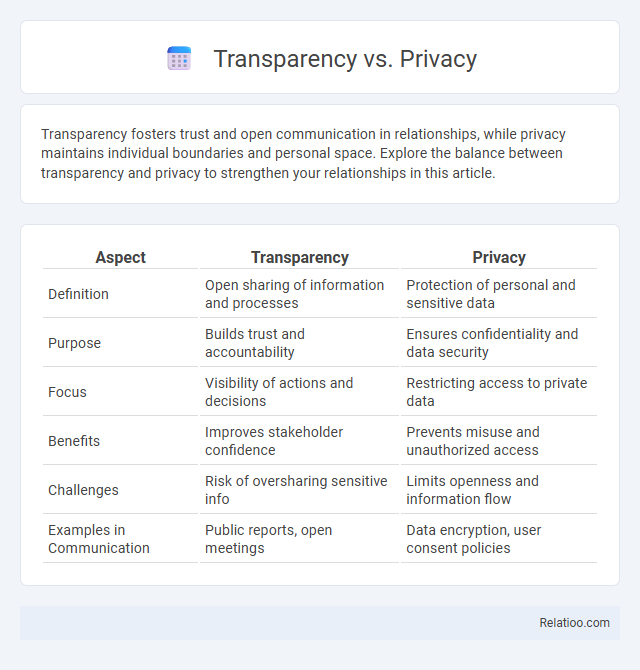Transparency fosters trust and open communication in relationships, while privacy maintains individual boundaries and personal space. Explore the balance between transparency and privacy to strengthen your relationships in this article.
Table of Comparison
| Aspect | Transparency | Privacy |
|---|---|---|
| Definition | Open sharing of information and processes | Protection of personal and sensitive data |
| Purpose | Builds trust and accountability | Ensures confidentiality and data security |
| Focus | Visibility of actions and decisions | Restricting access to private data |
| Benefits | Improves stakeholder confidence | Prevents misuse and unauthorized access |
| Challenges | Risk of oversharing sensitive info | Limits openness and information flow |
| Examples in Communication | Public reports, open meetings | Data encryption, user consent policies |
Understanding Transparency and Privacy
Understanding transparency involves openly sharing information to build trust, while privacy emphasizes protecting personal data from unauthorized access. You must balance transparency to foster accountability with privacy to safeguard sensitive information in digital environments. Clear policies and selective information disclosure create a framework where transparency supports ethical practices without compromising individual privacy.
Historical Context of Transparency and Privacy
Historical context reveals that transparency has long been valued for promoting accountability and trust in governance, dating back to the democratic principles of ancient Athens and the Magna Carta. Privacy emerged as a crucial counterbalance with the rise of industrialization and modern surveillance technologies, safeguarding individual rights against intrusive authorities. Navigating the tension between transparency and privacy remains essential for protecting Your freedoms in an increasingly interconnected world.
Key Differences Between Transparency and Privacy
Transparency involves openly sharing information to promote accountability and trust, whereas privacy centers on protecting personal or sensitive data from unauthorized access. Key differences include transparency's emphasis on visibility and openness in processes, contrasted with privacy's focus on confidentiality and control over personal information. Balancing these priorities requires clear policies that delineate what information should be disclosed while safeguarding individual rights.
Benefits of Transparency in Society
Transparency fosters trust by allowing your community to access clear and accurate information, promoting accountability in both public and private sectors. Open communication reduces corruption and misinformation, empowering citizens to make informed decisions. Increased transparency strengthens democratic processes and encourages ethical behavior across society.
Importance of Privacy in the Modern World
Privacy in the modern world is crucial as it safeguards personal data against unauthorized access and misuse in an era dominated by digital communication and big data analytics. Maintaining privacy ensures individuals' control over their personal information, preventing identity theft, surveillance, and breaches of confidential information. Balancing transparency with privacy is essential to foster trust while protecting sensitive details from exploitation and maintaining autonomy in an interconnected digital landscape.
Challenges in Balancing Transparency and Privacy
Balancing transparency and privacy presents significant challenges as organizations strive to provide clear, accessible information without exposing sensitive personal data. Ensuring compliance with regulations like GDPR requires sophisticated data management techniques to anonymize user information while maintaining accountability. Conflicts often arise when transparency efforts risk revealing proprietary or confidential details, necessitating robust frameworks to protect privacy without compromising openness.
Transparency vs Privacy in the Digital Age
Balancing transparency and privacy in the digital age presents complex challenges as data sharing enhances accountability but risks personal information exposure. Organizations must implement robust security measures and clear policies to protect your privacy while maintaining transparent communication. Advancing technologies like encryption and selective disclosure enable greater transparency without compromising sensitive data integrity.
Real-World Examples of Transparency and Privacy Conflicts
Real-world examples reveal the tension between transparency and privacy, such as government surveillance programs intended to enhance national security yet raising concerns over individual privacy violations. Corporate data breaches expose sensitive customer information, highlighting the need for transparent communication while safeguarding personal data. Your understanding of these conflicts helps navigate the delicate balance between openness and protecting personal privacy rights.
Legal and Ethical Considerations
Balancing transparency and privacy demands rigorous adherence to legal frameworks such as GDPR and HIPAA, which enforce stringent data protection and consent standards. Ethical considerations require organizations to maintain accountability by openly sharing pertinent information while safeguarding individual privacy rights to prevent misuse or discrimination. Achieving this balance involves transparent data handling policies that respect user autonomy and comply with regulatory mandates to build trust and uphold moral responsibility.
Future Trends: Evolving the Transparency-Privacy Balance
Emerging technologies like blockchain and differential privacy are reshaping the transparency-privacy balance by enabling verifiable data sharing without compromising personal information. Regulatory frameworks such as GDPR and CCPA are increasingly influencing organizational policies to prioritize both user privacy and transparent practices. Future trends indicate a growing adoption of AI-driven privacy-preserving tools that facilitate ethical data use while maintaining accountability and trust.

Infographic: Transparency vs Privacy
 relatioo.com
relatioo.com